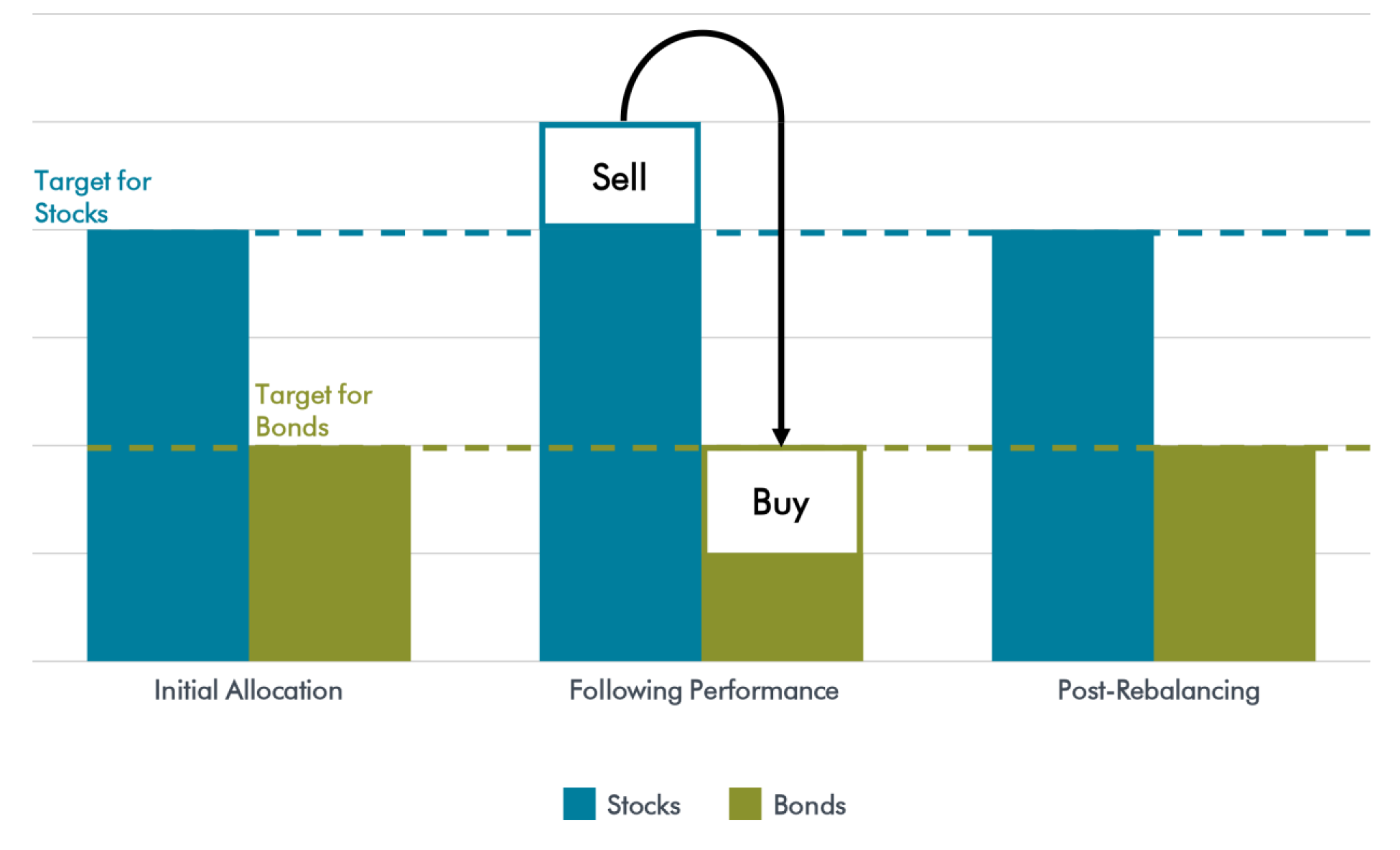The performance of equity and bond markets in the first quarter of 2021 has been as close to opposite of the start of 2020 as it gets. A year ago, stock markets had dropped as lockdown began, with the sole source of light being long-term Treasury bonds that were up 22.9% through March 23, 2020 (the bottom of the drop for the S&P 500 Index).1 The pullback impacted large technology stocks less and they recovered faster. Large Growth (as proxied by Russell 1000 Growth Index) was up 9.2% for the six months ending June 30, 2020 while Small Value (as proxied by the Russell 2000 Value Index) lagged far behind for the same period with a return of –24.4%. That is a 33.6% difference in return. Staying invested during this period was hard. It was even harder for long-term value and small company investors to stay invested. It was harder still to rebalance from bonds back into these strategies. Staying invested proved to have huge rewards.
Fast forward to 2021 and a very different picture has been drawn, a picture that was difficult to even imagine for anyone in 2020. Those large technology stocks have struggled in 2021 with a return of only 0.7% as of March 31 compared to a return of 20.7% for small and value stocks.
Meanwhile, Treasury bonds that held up so well during the drop in the stock market during the first quarter of 2020 are lagging with a return of –13.9% through the first quarter of 2021. This is a reminder that diversification works over the long term, but well-diversified portfolios usually have some portion of the portfolio that is not doing well.
Going a bit deeper on Treasury bonds, they have lost value in 2021 as long-term interest rates have gone up. Short-term rates have stayed near zero and are expected to go up, but that does not imply that long-term rates will go up above current expectations. Based on today’s Treasury rates and what is implied within long-term interest rates, markets have already priced in interest rate hikes of up to 2.75% which is 11 interest rate hikes of 0.25% from current levels. If rate hikes are as expected, or slower or fewer, then long-term bonds would make money over the next few years. If rate hikes are faster or greater than the market currently expects, then long-term bonds could lose money. That is why in five out of the last six rate hike cycles, long-term bonds have had positive returns.
We also want to illustrate how tough it is to market time these recoveries. The start of the recovery happened fast. Very fast. And it happened well before anything looked better. The chart below shows the difference between returns starting on March 23, 2020 and March 30, 2020 through March 31, 2021. For anyone trying to time the market, getting back in before the recovery started was nearly impossible. That one week represented about a –19% difference in return!

The goal of most investors is to maximize returns on an after-tax basis for a targeted level of risk. There are a few things that are within our control when framing a financial and investment plan, as well as things we cannot predict or control that may influence adjustments to the plan. As part of our strategy, we like to use the levers we can control to make sure we are managing portfolio risk and minimizing taxes.
What we can control when building a plan:
- Staying invested for the long term
- Diversification
- Asset allocation
What we cannot control but will influence adjustments to the plan:
- Long-term returns
- Inflation
- Interest rates
- Tax law and tax rates
Through the market turmoil witnessed during much of last year, we stressed the importance of staying invested long term when there is volatility in the short term and having proper diversification from a risk and return perspective when comparing single stock returns to a diversified portfolio. Asset allocation is another approach we employ across our clients’ financial plans.
Every individual’s risk tolerance and investment time horizon will vary. Even more, the personal and financial goals of each individual are vastly different. Therefore, there is no one-size-fits-all allocation. We aim to balance the risk and reward by allocating the portfolio into different asset classes according to a client’s current financial picture and tolerance for risk.
Managing Portfolio Risk Through Rebalancing
As we have seen in the first quarter of 2021 and in the first quarter of 2020, asset classes experience different performance. Since bonds have underperformed thus far this year, the original allocation in the portfolio may have drifted to overweight stocks and underweight bonds. To correct for these drifts in allocation, we employ rebalancing typically in terms of the following three factors:
- Stocks versus bonds
- Domestic versus international
- Asset class allocation
Back in the first quarter of 2020, a majority of clients sold out of bonds that were up as much as 22.1% from January 1 to March 31 and bought stocks that had dropped 21.3% during the same period (and at one point were down up to 32%). In the second half of 2020 and in the first quarter of 2021, portfolios did the opposite, clients saw their portfolios rebalance or sold out of stocks that have rallied 60% since the first quarter of 2020 and bought bonds that have since been down 16.7% from where they were sold in March 2020.
Rebalancing has the ability to reduce portfolio volatility and keeps a portfolio aligned with an individual’s risk and return preferences. In addition, it allows the portfolio to consistently buy low and sell high. We continually monitor portfolio allocations and will trade whenever allocations drift from a predetermined range, while avoiding whenever possible realizing capital gains in the process.
Reducing Portfolio Taxation Through Asset Location
By diversifying your exposure to many asset classes and allocating your portfolio based on your risk tolerance, we need to be cognizant of the different tax treatments depending on which asset we are looking at. How an asset is taxed will determine where it should be located. The purpose of asset location is to help maximize your after-tax return by determining which assets should be held in taxdeferred accounts and which assets should be held in taxable accounts.
 By properly locating assets, individuals can increase their after-tax returns by holding broad market funds and other low-turnover equity funds in taxable accounts while holding REITs and less tax-efficient assets in tax-deferred accounts.2 We help manage your overall allocation strategy by employing this technique.
By properly locating assets, individuals can increase their after-tax returns by holding broad market funds and other low-turnover equity funds in taxable accounts while holding REITs and less tax-efficient assets in tax-deferred accounts.2 We help manage your overall allocation strategy by employing this technique.
Through asset allocation and holding a globally diversified portfolio, it is our belief these strategies will help you meet and achieve your long-term financial goals. If you have questions about your plan and how asset allocation is being employed, please contact your financial advisor.
Sources
1 Long-term bonds as proxied by iShares 20+ Year Treasury Bond ETF. The proxy tracks investment results of the ICE U.S. Treasury 20+ Year Bond Index.
2 Robert M. Dammon, Chester S. Spatt, and Harold H. Zhang, “Optimal Asset Location and Allocation with Taxable and Tax-Deferred Investing,” The Journal of Finance, June 2004.
Meet With Your Advisor
It is important to let us know when you have any changes in your investment objectives or financial circumstances. It is also important to review your account beneficiaries each year to make sure that no personal changes need to be made and the primary and contingent beneficiary designations are up to date and accurate. To notify us about any such changes that have occurred since we last met with you, please contact our office and schedule a meeting with your advisor. We look forward to helping you stay on course.
PR Wealth Management Group, Inc. a Registered Investment Advisor. PR Wealth Management Group, Inc. only transacts business in states where it is properly registered, or notice filed, excluded or exempted from registration requirements. The home office is located at 990 Avenue of the Cities, Suite 4., East Moline, IL. 61244. Before making investment decisions please call our office at 309.792.8291 to receive a copy of PR Wealth’s Advisory Agreement and Form ADV Part 2A, which includes PR Wealth’s fee schedule. This information is intended to serve as a basis for further discussion with your professional advisors. Although great effort has been taken to provide accurate numbers and explanations, this information should not be relied upon for making investment decisions. Web: www.prwmg.com
Nothing in this publication should be construed as investment advice. All information is believed to be from reliable sources; however, its accuracy and completeness and the opinions based thereon by the author are not guaranteed and no responsibility is assumed for errors and omissions. Any economic and performance data published herein is historical and not indicative of future results. All rights reserved. Please consult your personal advisor and investment prospectus before making an investment decision.
*******************************
Sources
1 Matt Moran, “The Trends Behind the Russell 2000 Index’s Record Monthly Gain.” Cboe, December 9, 2020.
2 Matthew Ziehl, Adam Weiner and Jason Farrell, “Small-Cap Stocks Have Historically Outperformed After Recessions.” Invesco, June 30, 2020.
3 Jonathan Wheatley, “Foreign Investors Dash into Emerging Markets at Swiftest Pace Since 2013.” Financial Times, December 17, 2020.
4 Alexander Bick, Adam Blandin and Karel Mertens, “Commuting Patterns During COVID-19 Endure; Minorities Less Likely to Work From Home.” Federal Reserve Bank of Dallas, September 1, 2020.
5 Lori Ioannou, “1 in 4 Americans Will Be Working Remotely in 2021, Upwork Survey Reveals.” CNBC, December 15, 2020.
